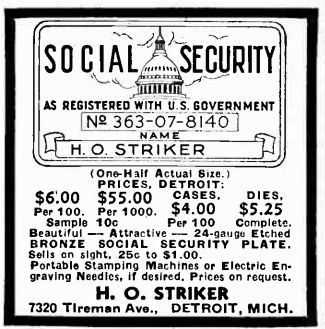Wednesday, October 25, 2017
Vestigially wrong
BBC's Future section has a mildly interesting article on vestigial features in common objects. Most of the alleged origins make sense, but two of them strike me as wrong. I'm sure of the first one, not sure of the second.
= = = = =
First, BBC claims that the Diner's card has rounded edges because....
 When Social Security was new, people wanted a more permanent card than the square-cornered card issued by SSA. Vending machine operators obliged with a round-cornered card containing an engraved plate. Library cards and store charge plates were similar, well before the Diner's Card.
Maybe Mr Diner wanted to be unusual. Maybe he printed up the first batch (fairly expensive with engraved serial numbers), realized at the last minute that a sentence on the bottom was improper, then cut the bottom off to meet a deadline.
= = = = =
Second: The article quotes a Wikipedia explanation for America's right-hand driving habit. The explanation seems to have appeared first in Popular Science in 1925.
When Social Security was new, people wanted a more permanent card than the square-cornered card issued by SSA. Vending machine operators obliged with a round-cornered card containing an engraved plate. Library cards and store charge plates were similar, well before the Diner's Card.
Maybe Mr Diner wanted to be unusual. Maybe he printed up the first batch (fairly expensive with engraved serial numbers), realized at the last minute that a sentence on the bottom was improper, then cut the bottom off to meet a deadline.
= = = = =
Second: The article quotes a Wikipedia explanation for America's right-hand driving habit. The explanation seems to have appeared first in Popular Science in 1925.
In 1949, Frank McNamara was dining with clients at Majors Cabin Grill Steak House, New York. When the bill arrived, he realised that he had left his wallet at home in another suit. There are a lot of rumours about what happened next. ... Regardless of the truth, a year later McNamara returned to the restaurant and paid with a small cardboard card known as the Diners Club Card. This was a landmark step in the development of the credit card – the first multipurpose charge card. “I had a look in the archive to the first 2,000 that they made. They’re not the same shape that they are now,” says O’Hara. Instead the cards were rounded at the top two corners. “It’s a really unusual shape. The only other example is a rolodex card.”A Rolodex card was larger than a credit card, rounded on all corners, and had two T-shaped slots in the bottom. No reason to assume it was the origin. Clipped or rounded corners have always been a desirable feature on cards that need to slip in and out of wallets or pockets. A square corner splits or folds over quickly, making the card unusable and unstackable. Here's a 1938 example from Billboard:
 When Social Security was new, people wanted a more permanent card than the square-cornered card issued by SSA. Vending machine operators obliged with a round-cornered card containing an engraved plate. Library cards and store charge plates were similar, well before the Diner's Card.
Maybe Mr Diner wanted to be unusual. Maybe he printed up the first batch (fairly expensive with engraved serial numbers), realized at the last minute that a sentence on the bottom was improper, then cut the bottom off to meet a deadline.
= = = = =
Second: The article quotes a Wikipedia explanation for America's right-hand driving habit. The explanation seems to have appeared first in Popular Science in 1925.
When Social Security was new, people wanted a more permanent card than the square-cornered card issued by SSA. Vending machine operators obliged with a round-cornered card containing an engraved plate. Library cards and store charge plates were similar, well before the Diner's Card.
Maybe Mr Diner wanted to be unusual. Maybe he printed up the first batch (fairly expensive with engraved serial numbers), realized at the last minute that a sentence on the bottom was improper, then cut the bottom off to meet a deadline.
= = = = =
Second: The article quotes a Wikipedia explanation for America's right-hand driving habit. The explanation seems to have appeared first in Popular Science in 1925.
Then the balance of power shifted. In the United States, wagons were increasingly common on the roads. Drawn by up to 20 animals, they were a popular way of transporting goods over long distances – and the men helming these vehicles liked to drive on the right. They’d sit on the rear leftmost horse, so it was easier to make sure oncoming traffic didn’t get too close if it was also on the left. There wasn’t any arguing with the momentum of 20 1,000-pound (453kg) horses. Other road traffic quickly got used to driving on the right and the rule stuck. Hundreds of years on, right-side driving is irreversibly embedded in US street design.Supposedly some drivers of Conestoga wagons formed a national habit. I can't prove this one wrong, but a tendency among some long-distance freighters seems unlikely to set a habit for city streets. More likely:
In France, traditionally foot traffic had kept right, while carriage traffic kept left. Following the French Revolution, all traffic kept right. The first keep-right law for driving in the United States was passed in 1792 and applied to the Philadelphia and Lancaster Turnpike. New York formalized RHT in 1804, New Jersey in 1813 and Massachusetts in 1821.Note the dates. We were consciously following French trends and erasing British tendencies after the Revolution. This 1799 engraving of Philadelphia streets shows carriages on the right.
Labels: Asked and sort of answered
